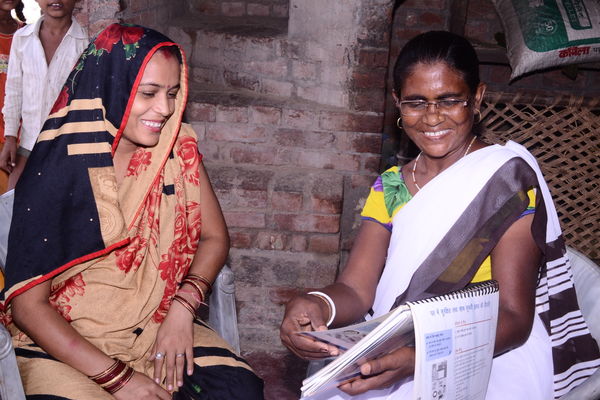Rajni, 23, pregnant with her second child is down and depressed. Persistent fever, weakness, and dizziness have taken a toll on her overall health. Medical help from local providers and traditional caregivers – the only resource available in her remote Pangawan village in Kannauj, Uttar Pradesh, India – has not produced any improvement and in fact, has made her condition worse.
She suffered a miscarriage in her previous pregnancy and was running a risk of losing the child this time too. Seeking care from a formally qualified doctor is an unrealisable luxury; poverty and limited availability of transportation have made it immensely difficult for her to even think of going to Kannauj, a town 40 kilometers away, the nearest point where such providers are available.
When Suman, a community volunteer, learns from Rajni’s family about her condition, she informs them that they can see a doctor right in her own village. But Rajni is not convinced. After all, her village is cut off from the main road and is accessible only after a winding journey through a single beaten path. When the next day Rajni and Suman reach the venue – SkyHealth Center – 8 or more patients are already in the queue.
Rajni, at her turn sits in front of a computer, and with the help of a local entrepreneur, speaks to a well-qualified doctor in distant Delhi. The doctor is able to get Rajni’s vital parameters – blood pressure, pulse, foetal rates, and temperature.
During Rajni’s consultation with the city based doctor she was diagnosed with malaria, a life-threatening mosquito-borne blood disease. Rajni was prescribed medicine that provided relief from vomiting and improved her health. It was recommended she take iron and folic acid supplements along with calcium and counselled to eat more green leafy vegetables, fruits, milk, etc. Over the course of her pregnancy, Rajni gained over 11 pounds and gave birth to a healthy girl. Many young mothers like Rajni and children have benefitted from this timely referral and consultation close to their home.
The doctor is one of many based at the central medical facility of World Health Partners (WHP), an Indian NGO that uses technology to deliver health care to rural communities. WHP uses a technology platform by which poor, marginalized communities can get medical assistance from a formal health network irrespective of their location. Besides giving the ability to doctors to get vital parameters, WHP also creates a set of support services such as rapid diagnostics, generic medicines priced low, and referrals, right at the village community’s doorsteps.
WHP has over 12,000 ‘Sky Centers’ – WHP’s technology-enabled centers based in rural villages – run by local entrepreneurs that administer care to those most in need and are located in the remotest areas of Bihar and Uttar Pradesh. These are two of the largest and poorest states in India, with a combined population of over 300 million.
WHP harnesses the latest advances in communication, diagnostic, and medical technology to establish sustainable service delivery networks. WHP’s technology solution plays a critical role in contributing to the overall effectiveness of the program in a variety of ways:
- by providing access to city based, formally qualified doctors;
- increasing provision of maternal health products and services by linking with an electronic supply chain;
- creating a cloud-based medical record of patients and clients which can be accessed from various levels;
- alerts and reminders to clients and providers for ensuring minimal follow up defaults; and
- providing opportunity for rural providers (AYUSH & Paramedical) to receive continued medical education.
The core of WHP's technology is the special application installed on a laptop or tablet used by the provider, which accepts diagnostic tools on a plug-and-play basis and many computer-based tools that enable doctors in other cities to deliver standardised care expeditiously.
WHP's system is tailored to work in extremely low resource settings. Its Althea Plus system works with a bandwidth of 40 kbps making it suitable for areas where only 2G connectivity is available. With better connectivity, the quality of consultations improves, such as sharper videos.
On the backend, WHP runs a call center that is useful for cases that require aggressive follow-up over long periods, such as tuberculosis treatment or antenatal care. Based in Patna, it handles case registrations, product placement, reimbursement of claims, client satisfaction probes, and alerts.
WHP’s work within India encompasses pediatric and TB care in Bihar, maternal and reproductive health in Uttar Pradesh, and TB projects in West Bengal, Jharkhand, and Gujarat. In Kenya, WHP is currently administering a pilot project of three clinics that addresses the health and reproductive health needs of rural communities. The project is called Maisha Clinics and is primarily focused on women and children; these facilities are located in Homa Bay County, one of the poorest counties in western Kenya.
You can view many inspiring and success stories such as Rajni’s and read more about WHP’s innovative technology at http://worldhealthpartners.org/ .

